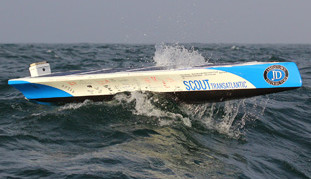A team of young DIYers from Tiverton, RI in the US have built the Scout to attempt the first autonomous Transatlantic crossing by a surface craft. Power for the 12 ft boat comes from four 30 W solar panels built into the deck, charging a lithium-iron-phosphate battery. One of the...
A team of young DIYers from Tiverton, RI in the US have built the Scout to attempt the first autonomous Transatlantic crossing by a surface craft. Power for the 12 ft boat comes from four 30 W solar panels built into the deck, charging a lithium-iron-phosphate battery. One of the two Arduino Mega boards used in the design handles navigation while the second Mega takes care of sensor data and communications via an Iridium satellite transceiver.
Failsafe measures built into the design include a hard reset of the Arduinos every 12 hr to recover from any power supply brown out event or memory malfunction. The boat’s course is set by navigating to preprogrammed GPS waypoints. It periodically performs a reverse maneuver to clear seaweed or debris which may have fouled the propeller.
You can check Scouts progress on the team’s web page, the last time I looked it was 37 days into the mission and 1010 miles from Rhode Island. If all goes to plan it will make landfall at Sanlucar de Barrameda, Spain, the place where Columbus began his second journey to the New World.



Discussion (0 comments)